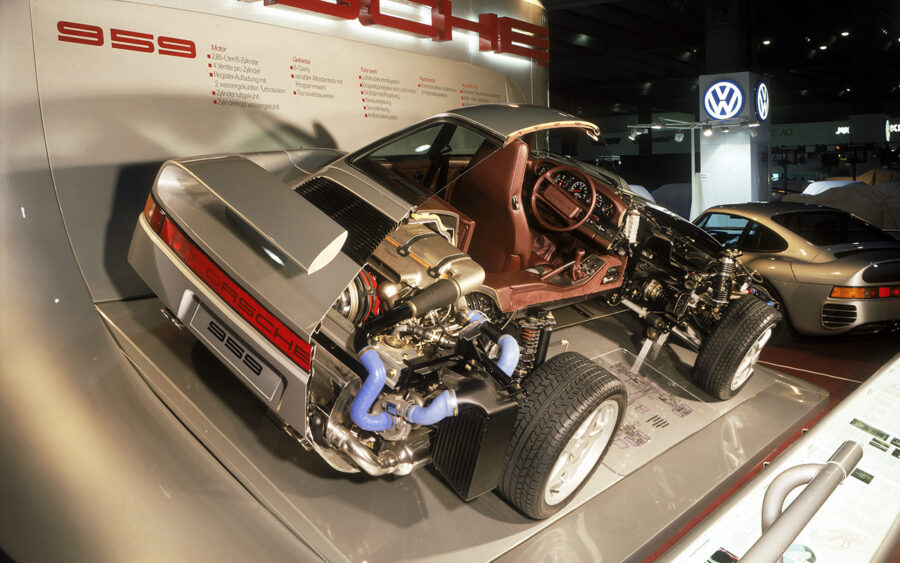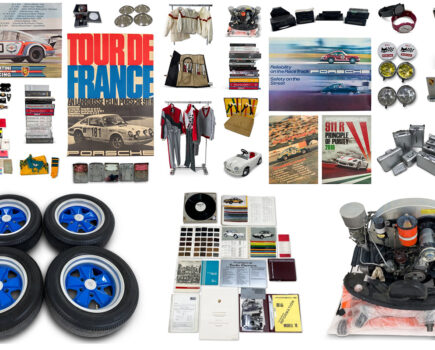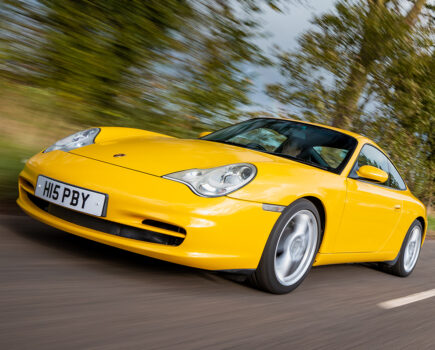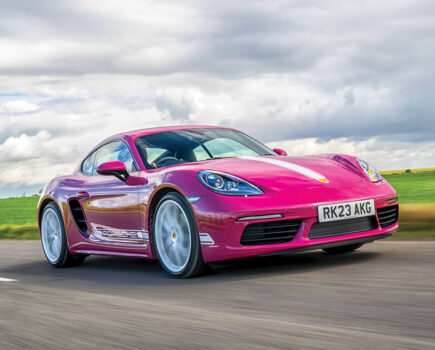Sequential turbocharging was introduced with the Porsche 959 and has since influenced countless other Porsche products. Here’s how it works
Words: Shane O’Donoghue
Although turbocharged cars from other manufacturers preceded the 930 (911 Turbo), Porsche’s introduction of forced induction to its flagship model in 1974 is seen as a notable milestone for the automotive industry, not least because engineers in Stuttgart were dedicated to developing and refining the technology in an evolutionary process continuing today. The 930 was, in fact, conceived only to homologate the 935 race car, but despite its flaws (and price), the roadgoing boosted Porsche proved popular, becoming a mainstay of the company’s product line.
Revealed to the public at the 1974 Paris Motor Show, the 930 went on sale in time for the 1975 model year. Its three-litre, air-cooled flat-six used a single turbocharger and initially produced 256bhp and 243lb ft torque against a maximum of 207bhp for the 911 range’s naturally aspirated 2.7-litre boxer. Porsche increased the capacity of the turbocharged engine to 3.3 litres for 1978, but perhaps of more significance to the success of the 930 was the introduction of an air-to-air intercooler. This sat under the now famous ‘whale tail’ rear spoiler and cooled combustion air after it was compressed by the turbo, enabling output to be raised to a mighty-for-the-time 296bhp and 304lb-ft torque.
This was remarkably close to being the end of the 911 story. Ernst Fuhrmann (Chairman of the Board for eight years until 1980) was thought to be planning to discontinue the 911, along with its air-cooled boxer engines, in favour of the front-engined, water-cooled transaxle family of Porsche models. Anecdotally, many of his colleagues were less than happy about this proposal, which came to nought when Fuhrmann was replaced by Peter Schutz in 1981. His intention? To develop the 911 further, indefinitely.
Helmuth Bott, an engineering whizz and Porsche’s director of research and development, had already started planning the first open-topped version of the 911 (a prototype Cabriolet) before Fuhrmann’s departure. The resulting design study was displayed in public at the 1981 Frankfurt Motor Show and made use of a turbocharged 930 engine and a then new four-wheel-drive system. In truth, it wasn’t a very sophisticated setup, borrowing a driveshaft from the 924 to bring drive to the front axle, plus a differential from the 924 Turbo to apportion power between the front wheels, but behind the system’s existence was the influence of Manfred Bantle, an accomplished engineer, who also worked on the design and development of the 928’s clever Weissach rear axle.
Group B racing, sequential turbocharging and the Porsche 959
After the show, things were perceived to have gone quiet as far as the technology previewed in Frankfurt was concerned, but behind the scenes work began on something rather more magnificent. Bott got the go ahead from Schutz not only to put his design for a 911 Cabriolet (the first full Porsche drop-top since the demise of the 356) into production, but also to explore the powertrain ideas in the Cabriolet concept further. A test mule was constructed to prove the concept of all-wheel drive, and the green light was given to develop a car that could compete in Group B racing.
Group B, introduced in 1982 by the FIA, was designed to be a replacement for Group 4 and Group 5. Where Group A cars were largely based on mass-produced models, there was huge freedom in Group B, with no cap on turbo boost or technology. It was deemed to be the perfect showcase and proving ground for Porsche’s most ambitious project yet, an extreme evolution of the 911. Two years later, at the 1983 Frankfurt Motor Show, Porsche took the covers off its spectacular Gruppe B concept car and announced its intention to compete on the world rally stage, with tobacco company, Rothmans, serving as main sponsor.
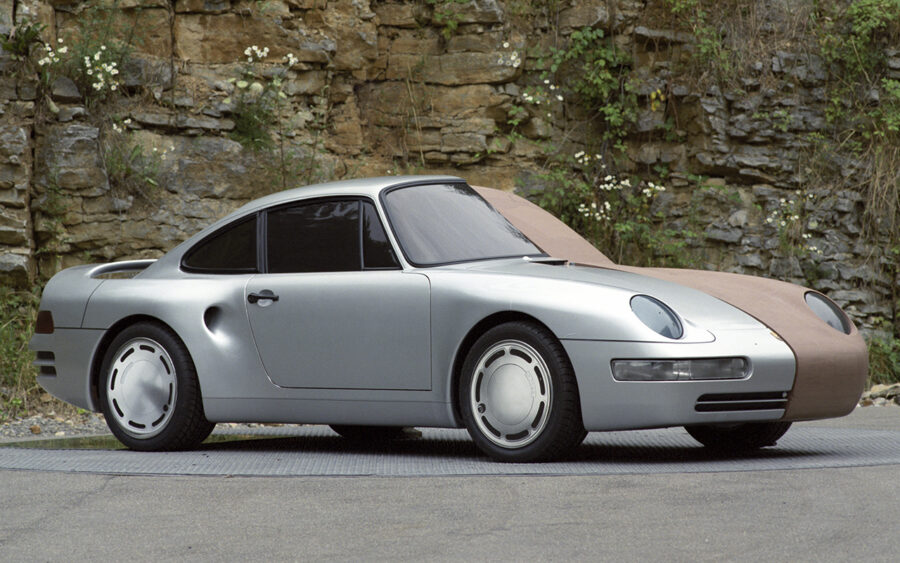
The Porsche 965 was a stillborn model based around 959 styling, but intended to be offered at a much cheaper price point
To fit in with the car’s exotic nature and the plan to compete with what would go on to become the 959, Porsche turned to its racing department for an engine, adopting a special 2.85-litre variant of the tried-and-tested flat-six. The same displacement was employed by the earlier 935 race car in 1976, taking the three-litre turbocharged boxer from the 930 as its basis. The FIA applied a multiplication factor of 1.4 to turbocharged engines, however, meaning in order to compete in the under-four-litre category, the engine’s swept capacity was decreased by reducing the diameter of the bore.
Porsche struggled with head gasket issues in 1977 and considered developing an all-new race engine using water cooling. Group 5 rules prevented this, dictating how the air-cooled engine block, crankcase and cylinders from the road-going 911 had to be used to satisfy homologation requirements. Thankfully, a water-cooled cylinder head was permitted, which allowed for a complete redesign of the valve gear. Porsche took the opportunity to fit individual camshafts for inlet and exhaust and four valves per cylinder, massively improving the breathing of the engine.
Over time, the unit underwent a huge number of iterations in its motorsport setting before it was employed as the 959’s beating heart. Nonetheless, the cooling concept was carried over, with water cooling for the double overhead camshaft, four-valves-per-cylinder heads and air cooling for the aluminium crankcase and cylinder blocks. A 95mm bore and 67mm stroke resulted in a 2,849cc capacity, while expensive titanium connecting rods to keep the reciprocating mass down. A dry sump lubrication system was also used, in recognition of the intention to put the 959 to work in a competition environment, both on rally stages and at the 24 Hours of Le Mans.
Porsche sequential turbocharging: how it works
Back to the turbocharging. Some of Porsche’s previous 2.85-litre race engines used single turbochargers, though most used two, one for each bank of cylinders, always spinning. This configuration is what’s referred to as parallel turbocharging. It’s great for producing a huge amount of boost at high engine speeds and loads, such as in competition applications. Porsche’s experience with the 930 and the model’s extreme lag, however, convinced factory engineers the 959 needed far more sophistication. They reasoned a single small turbo would improve response at low engine speeds and loads, but would limit outright boost, while back pressure in the exhaust caused by this setup could negatively impact fuel economy. In contrast, a single large turbocharger would provide plenty of boost, but would result in more of the lag Porsche was trying to avoid. Enter the world’s first sequential turbocharging system.
The 959’s engine uses two turbochargers, mounted on the back of the unit, one on each side. At low speeds, the flat-six operates in single turbo mode, with all combustion air and exhaust gas flowing through the left-hand turbo. This is achieved by closing turbine cut-in and compressor cut-in valves on the second turbo, ensuring no gases can flow through it. Hence, all the exhaust gases from the right-hand cylinder bank flow to the left-hand turbine through a transverse pipe. This quickly gets the turbo up to operating speed by way of a relatively small turbine. The wastegate is also closed at this point and, when exhaust gas flow is registered as ‘too much’ for the left-hand (primary) turbocharger, the excess is sent to the right-hand turbocharger. This is regulated by the turbine cut-in valve and has the effect of immediately accelerating the right-hand turbocharger up to speed. At this stage, the compressor cut-in valve is still closed, despite air pressure building up on the right side.
The process is controlled via a relief valve until there’s enough exhaust flow to fully supply both turbochargers. The relief valve then closes and the turbine cut-in valve opens fully, rapidly increasing air pressure downstream of the right-hand compressor. The compressor cut-in valve is opened and both turbochargers become fully operational. Porsche records shows that, in this setting, the turbos get an equal share of exhaust gas flow and the overall boost pressure is managed by the wastegate. Peak boost pressure was reported to be 1.0bar.

Porsche 959 twin-turbo 2.8-litre flat-six
All this complexity was only possible because Porsche adopted advanced (for its day) electronic computing to control the system, though the basic premise of the idea is simple enough to comprehend. Two air-to-air intercoolers fed cool air through the 959’s intake vents, located ahead of the rear wheels, encouraging 450bhp at 6,500rpm and 369lb-ft of torque at 5,500rpm. Those were heady figures for the mid-1980s and, if we’re being honest, they’re not too shabby today, enabling the 959’s sprint to 62mph from rest in 3.7 seconds and a top speed of 197mph. Of course, there was much more to come from that extraordinary engine, including its development for the ultra-rare 959 S, which used bigger turbos, sacrificing drivability in the name of outright power. The model produced up to 508bhp and managed to romp all the way to 211mph. In the 961 track racer (a circuit dwelling variant of the 959), the engine was developed even further, knocking on the door of 680bhp.
Porsche 959: leaving a technological legacy
As revered as the 959 is by marque enthusiasts (and collectors of appreciating classics) today, the all-pawed Porsche cost the company a fortune to develop and, despite its huge purchase price, Porsche lost money on every unit sold. Even so, the 959 is regarded as an invaluable investment in the development of Porsche technology, though it took a while for the model’s exciting innovations to become commonplace in the wider Porsche product portfolio. For example, the 964 was the next generation of 911 to launch after the 959’s introduction, but the 964 Turbo continued to use the 930’s single turbocharged engine as its basis. This came as disappointment to many, not only because it suggested a lack of time had been allocated to develop the 964’s 3.6-litre M64 engine into something sufficiently different to the late 930’s powerplant (though minor revisions were made to reduce lag, encourage smoother operation and add more power), but also because it signalled the end of the 965 project — many will incorrectly refer to the 964 Turbo as 965, but this was, in fact, a separate model intended to become Porsche’s range-topper by adopting the 959’s basic powertrain, styling and chassis architecture, but offered at a more attainable price point.
The 3.6-litre 964 Turbo eventually arrived in 1993, and though the Carrera 4 was the first production 964 launched back in 1989, it wasn’t until the launch of the twin-turbocharged, four-wheel drive 993 Turbo in 1995 that the 959’s sequential turbocharging influence was truly felt in the 911 range.
This was the first time a duo of turbos was used in the assembly of a production 911, but despite the rapid evolution of engine electronics in the intervening years, the 993 Turbo dispensed with the 959’s complex sequential turbocharging system and instead featured two identical, relatively small turbochargers, compromising between low-speed response and top-end power. Boost pressure topped out at 0.8bar, enabling 402bhp and a non-too-shabby 398lb-ft of torque.
In fact, despite its ground-breaking development, sequential turbocharging didn’t appear to go any further than the 959 in Porsche’s world, even though it is commonly used by other manufacturers today. Undoubtedly, the technology’s design educated Porsche’s engineers, teaching them much about how to optimise boost pressure for a variety of conditions.
These learnings unquestionably resulted in the development of the Variable Turbine Geometry (VTG) turbocharger, which effectively does the work of a sequential turbocharging system all within a single turbo. At low exhaust gas speeds (low engine speeds and loads), vanes on the inlet to the turbine restrict the flow path to speed up gas flow. These vanes open up the flow path at higher speeds to make full use of the energy in the exhaust.
And in case you were wondering, the excellent 997 Turbo was the first Porsche to make use of this technology, which is still in use across the manufacturer’s range to this day.

